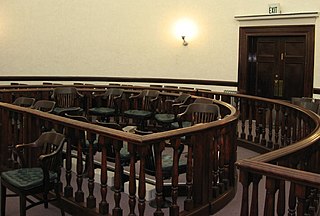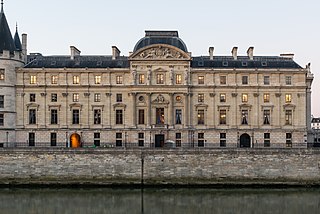
A jury is a sworn body of people (jurors) convened to hear evidence, make findings of fact, and render an impartial verdict officially submitted to them by a court, or to set a penalty or judgment.

The Court of Cassation is the supreme court for civil and criminal cases in France. It is one of the country's four apex courts, along with the Council of State, the Constitutional Council and the Jurisdictional Disputes Tribunal.
Corrado Carnevale is an Italian judge, and former president of the Italian Supreme Court of Cassation.

The Maxi Trial was a criminal trial against the Sicilian Mafia that took place in Palermo, Sicily. The trial lasted from 10 February 1986 to 30 January 1992, and was held in a bunker-style courthouse specially constructed for this purpose inside the walls of the Ucciardone prison.

The Supreme Court of Cassation is the highest court of appeal or court of last resort in Italy. It has its seat in the Palace of Justice, Rome.
In France, a cour d'assises, or Court of Assizes or Assize Court, is a criminal trial court with original and appellate limited jurisdiction to hear cases involving defendants accused of felonies, meaning crimes as defined in French law. It is the only French court that uses a jury trial.

The courts of appeal are the main appellate courts in the judicial system of Belgium, which hear appeals against judgements of the tribunals of first instance, the enterprise tribunals and the presidents of those tribunals in their judicial area. There are five courts of appeal for each of the five judicial areas, which are the largest geographical subdivisions of Belgium for judicial purposes. The division of the Belgian territory into the five judicial areas is laid down in article 156 of the Belgian Constitution. A judicial area covers multiple judicial arrondissements ("districts"), except for the judicial area of Mons. Each arrondissement has a tribunal of first instance. Further below, an overview is provided of the five courts of appeal and the judicial arrondissements their judicial area covers. It is important to note that the courts of appeal do not hear appeals against judgements of the labour tribunals; these are heard by the courts of labour.

The court of assizes is the trial court which tries the most serious crimes in the judicial system of Belgium. It is the highest Belgian court with criminal jurisdiction; as such, it is the only Belgian court that can sentence someone to life imprisonment. The courts of assizes are not permanent courts; a new court of assizes is assembled for each new trial. There is a court of assizes in each of the ten provinces of Belgium, as well as one in the arrondissement of Brussels-Capital which is not part of any province. Further below, an overview is provided of the eleven courts of assizes and their seats. They are the only courts in Belgium for which the provinces are used as territorial subdivisions. They are also the only courts in Belgium that hold jury trials. The jury acts as sole trier of fact, but decides on the penalty together with the judges. The trial by jury of certain crimes is laid down in article 150 of the Belgian Constitution. The Belgian courts of assizes have the same origin as their French namesakes.
Maria Clementina Forleo is an Italian preliminary judge at the Court of Milan.

The Italian Code of Criminal Procedure contains the rules governing criminal procedure in every court in Italy. The Italian legal order adopted four codes since the Italian Unification. After the first two codes, in 1865 and 1913, the Fascist Government established in 1930 a new code adopting an inquisitorial system. In 1988 the Italian Republic adopted a new code, that could be considered to be somewhere in between the inquisitorial system and the adversarial system.

The judiciary of Italy is composed of courts responsible for interpreting and applying the law in the Italian Republic. Magistracy is a public office, accessible only to Italian citizens who hold an Italian Juris Doctor and have successfully partaken in one of the relevant competitive public examinations organised by the Ministry of justice. The judicial power is independent and there is no internal hierarchy within. Italian magistrates are either judges or public prosecutors.

Meredith Susanna Cara Kercher was a British student on exchange from the University of Leeds who was murdered at the age of 21 in Perugia, Italy. Kercher was found dead on the floor of her bedroom. By the time the bloodstained fingerprints at the scene were identified as belonging to Rudy Guede, an Ivorian migrant, police had charged Kercher's American roommate, Amanda Knox, and Knox's Italian boyfriend, Raffaele Sollecito. The subsequent prosecutions of Knox and Sollecito received international publicity, with forensic experts and jurists taking a critical view of the evidence supporting the initial guilty verdicts.
The law of Vatican City State consists of many forms, the most important of which is the canon law of the Catholic Church. The organs of state are governed by the Fundamental Law of Vatican City State. The Code of Penal Procedure governs tribunals and the Lateran Treaty governs relations with the Italian Republic.
Giuliano Mignini is an Italian magistrate. He retired as a public prosecutor in Perugia, Umbria, in 2020.

The judiciary of Belgium is similar to the French judiciary. Belgium evolved from a unitary to a federal state, but its judicial system has not been adapted to a federal system.

In France, a cour d’appel of the ordre judiciaire (judiciary) is a juridiction de droit commun du second degré, a. It examines judgements, for example from the correctional tribunal or a tribunal de grande instance. When one of the parties is not satisfied with the verdict, it can appeal. While communications from jurisdictions of first instance are termed "judgements", or judgments, a court of appeal renders an arrêt (verdict), which may either uphold or annul the initial judgment. A verdict of the court of appeal may be further appealed en cassation. If the appeal is admissible at the cour de cassation, that court does not re-judge the facts of the matter a third time, but may investigate and verify whether the rules of law were properly applied by the lower courts.

The Supreme Court of the Dominican Republic is the highest court existing in the Republic and is, therefore, the head of the judiciary in the country.

The High Council of the Judiciary is an Italian institution of constitutional importance, entrusted to preside over the organisation of the Italian Judiciary. The High Council sits in the Palazzo dei Marescialli, Piazza Indipendenza 6, Rome.

The Circonvallazione massacre, in Italian Strage della Circonvallazione, is a Cosa Nostra attack that took place on June 16, 1982 on the Palermo ring road. The attack was directed against Catanese boss Alfio Ferlito, who was transferred from Enna to the Trapani jail, and died with the three escort carabinieri and the 22-year-old Giuseppe Di Lavore, the driver of the private company that had the transportation of prisoners, who had replaced his father. The mandators of this massacre were Salvatore Riina and Bernardo Provenzano, in favor to Nitto Santapaola, who was in a year-long war with Ferlito for the predominance on the city of Catania territory.
Alfredo Cospito is an Italian anarchist. In his twenties, he refused conscription to military service and was convicted of desertion, then pardoned after going on hunger strike for one month. In 2012, he was sentenced to 10 years for kneecapping the head of the Italian nuclear power company Ansaldo Nucleare. Whilst imprisoned, he was convicted of the 2006 bombing of a Carabinieri barracks in which nobody was harmed. The Supreme Court of Cassation later increased the sentence to life without parole.











